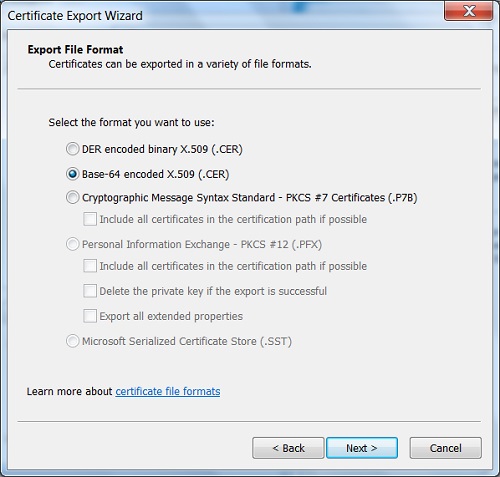PKI Tutorials - Herong's Tutorial Examples - v2.32, by Herong Yang
Exporting Certificate to File from IE
This section provides a tutorial example on how to export a trusted root CA certificate installed in IE into a certificate file encoded in Base64 format.
In previous tutorial, we learned how to use IE to view certificates installed in certificate stores. Now let's see if we can export a certificate out of a certificate store into a certificate file.
1. Run IE and click the "Tools" > "Internet Options" menu. The Internet Options dialog box shows up.
2. Click the "Content" tab and the "Certificates" button. The Certificates dialog box shows up.
3. Click the "Trusted Root Certification Authorities" tab. A list of trusted root CA certificates currently installed in IE is listed.
4. Select "VeriSign Class 3 Public Primary Certification Authority - G5" in the list, and click the "Export" button. The Certificate Export Wizard shows up.
5. Click the "Next" button. The Export File Format step shows up with these options:
Certificate can be exported in a variety of file formats.
Select the format you want to use:
( ) DER encoded binary X.509 (.CER)
(.) Base-64 encoded X.509 (.CER)
( ) Cryptographic Message Syntax Standard
- PKCS #7 Certificates (.P7B)
6. Select "Base-64 encoded X.509 (.CER)" as the export file format, and click the "Next" button. The File to Export step shows up.
7. Enter a file name: \temp\VeriSign_Root_CA_base64.cer, and click the "Next" button. The confirmation step shows up.
8. Click the "Finish" button. The selected certificate will be exported into the specified file.
The picture below shows you the export file format options in the Certificate Export Wizard:

Table of Contents
Introduction of PKI (Public Key Infrastructure)
Introduction of HTTPS (Hypertext Transfer Protocol Secure)
Using HTTPS with Google Chrome
Using HTTPS with Mozilla Firefox
►HTTPS with IE (Internet Explorer)
Visiting "https" Website with IE
Viewing Server Certificate Details in IE
Viewing Server Certificate Path in IE
Installing Server Certificate Permanently in IE
Viewing Certificates in Certificate Stores in IE
Listing of Trusted Root CA in IE
►Exporting Certificate to File from IE
Saving Server Certificate to File with IE
IE Supporting Multiple Certificate Paths
IE Reinstalling Root Certificates Automatically
Windows Automatic Root Update Mechanism
Android and Server Certificate
Windows Certificate Stores and Console
RDP (Remote Desktop Protocol) and Server Certificate
macOS Certificate Stores and Keychain Access
Perl Scripts Communicating with HTTPS Servers
PHP Scripts Communicating with HTTPS Servers
Java Programs Communicating with HTTPS Servers
.NET Programs Communicating with HTTPS Servers
CAcert.org - Root CA Offering Free Certificates
PKI CA Administration - Issuing Certificates
Comodo Free Personal Certificate
Digital Signature - Microsoft Word
Digital Signature - OpenOffice.org 3